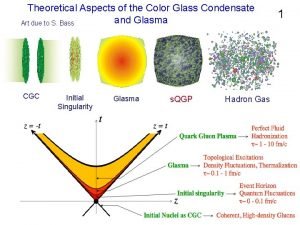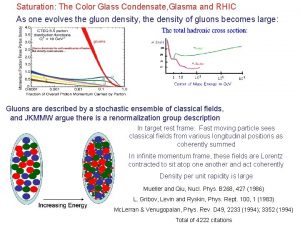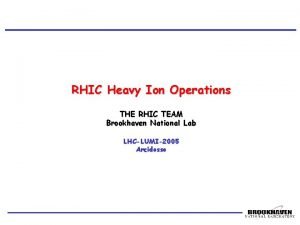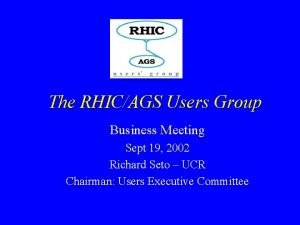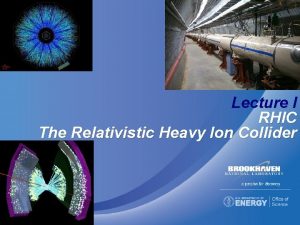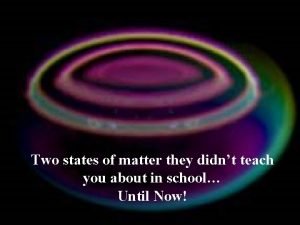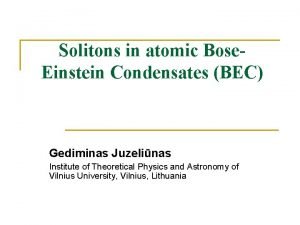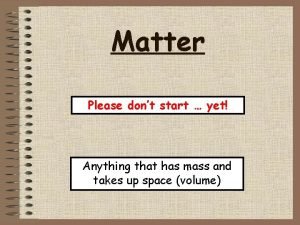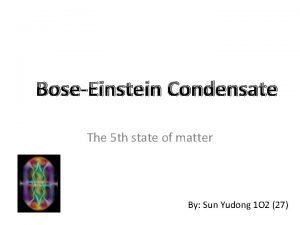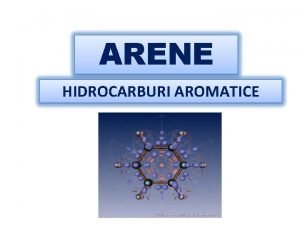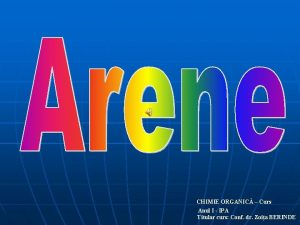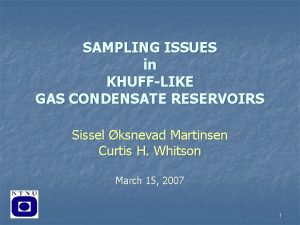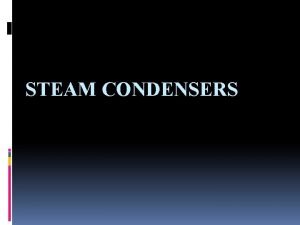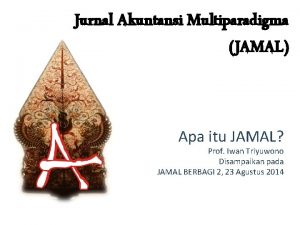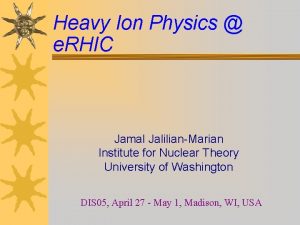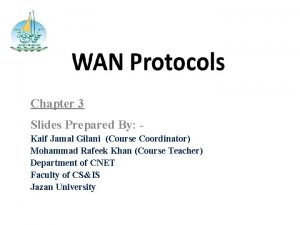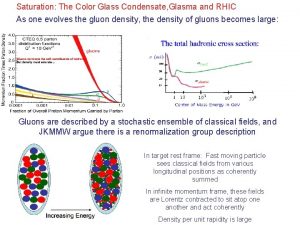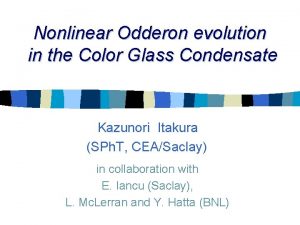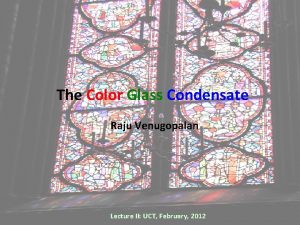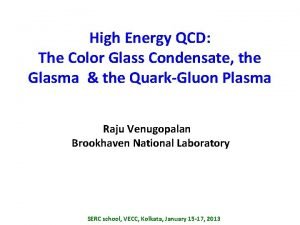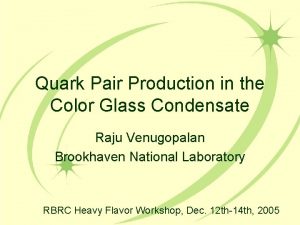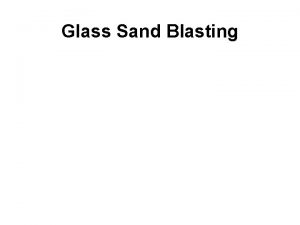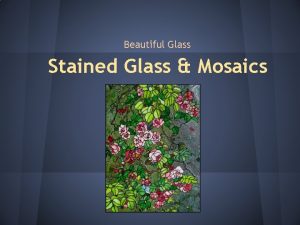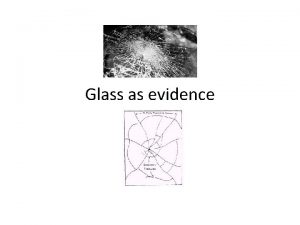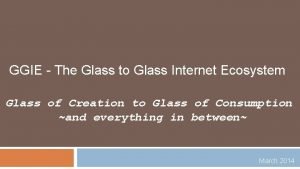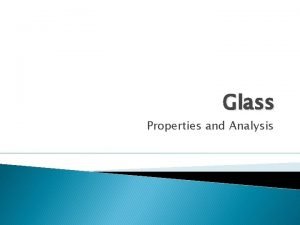Color Glass Condensate at RHIC Jamal JalilianMarian Institute
























- Slides: 24

Color Glass Condensate at RHIC Jamal Jalilian-Marian Institute for Nuclear Theory Seattle, Washington

OUTLINE • Quantum Chromo Dynamics – Perturbative QCD • Parton Model – Semi-Classical QCD • Color Glass Condensate • Color Quantum Fluid • Semi-Classical QCD at RHIC – Indications – Tests

Perturbative QCD • • • Quarks, gluons (x, Q 2) Weak coupling ( s << 1) Collinear factorization Incoherence Dilute systems

Semi-Classical QCD • Wilson lines • • Weak coupling ( s << 1) Classical fields + renormalization group Coherence (longitudinal): lc ~ 1/m. N x Dense systems

Gluon Saturation • Small X/Large A • Large occupation number • Coherent state • Saturation momentum Qs (x)

Qes Qs • • Color Glass Condensate Pt < Qs(y) Color Quantum Fluid Qs(y) < Pt < Qes(y) Dilute Parton Gas Pt > Qes(y) Where is RHIC?

QCD: Kinematic Regions • Color Glass Condensate – High gluon density – Strong classical fields – Non-Linear evolution: JIMWLK (BK at large Nc) • Color Quantum Fluid – Low gluon density – Linear evolution: BFKL – Anomalous dimension (kt factorization) • Dilute Parton Gas – Low gluon density – Linear evolution: DGLAP – No anomalous dimension (collinear factorization)

Coherence at RHIC • Multiplicity growth: from pp to AA – Incoherent scattering ~3 – Coherent scattering ~ 50%

Color Glass Condensate at RHIC • Gluon production • Multiplicities are correctly predicted • Beware of the fragmentation region

Color Glass Condensate at RHIC • Energy, Npart dependence: OK • Warning: saturation at s ~ 20 Ge. V !

Color Quantum Fluid at RHIC? • RAA < 1: initial state? – BFKL anomalous dimension: 1/Q 2 ---> (1/Q 2)0. 6 – Approximate Npart scaling • 2 ---> 1 processes (reduced back to back correlations)

d. A: Mid Rapidity • R_d. A (pt > 2 Ge. V) – Quantum evolution: not the dominant physics – Classical: MV model (Cronin effect)? • Correlations (pt > 4 Ge. V) – CGC: not the dominant physics

RHIC: Color Glass Condensate? • HERA (protons): X ≤ 0. 01 • Mid rapidity RHIC (AA): – Pt ~ 5 Ge. V --> X ~ 0. 1 – Pt ~ 1 Ge. V --> X ~ 0. 01 – Multiplicity (P_t < 1 Ge. V): OK – High Pt spectra: X is too large • Color Glass Condensate provides the initial conditions, but the physics of high pt is that of final state rescattering, energy loss, …. • Look forward in d. A

d. A: The Common Approach • Two main effects – Cronin • Intrinsic momentum – F(x, Q 2) --> F(x, kt 2, Q 2) – <kt 2>p. A = <kt 2>pp + k H[n] – Parameters from fitting data at low energy – Shadowing • Parameterize the data on structure functions • Gluon shadowing? • Phenomenological models – Parameters are process, energy, etc. dependent – No Universality ---> Predictability ?

d. A: The CGC Approach

Going Forward at RHIC • Assume saturation works for x ≤ x 0 [x 0~10 -2 --> Qs(x 0) ~ 1. 6 Ge. V] – For x ~ x 0: classical approximation (MV model) – Suppression (enhancement) at pt < (>) Qs • Forward: y = 0 ---> 2 ---> 4 – – – – x ~ 10 -2 ---> 10 -3 ---> 10 -4 << x 0 (pt ~ 2 Ge. V) Quantum evolution becomes essential Qs(y 0) = 1. 6 Ge. V ---> Qs(y=4) = 2. 6 Ge. V Qes(y 0) = 1. 6 Ge. V ---> Qes(y=4) = 4. 2 Ge. V Suppression at pt < Qes Centrality Reduced correlations (2 ---> 1 processes are dominant) • Forward rapidity: CGC and CQF regions open up

Forward Rapidity d. A • Illustration • Suppression of Rd. A as we go forward

Forward Rapidity d. A

Forward Rapidity d. A at RHIC • Deuteron fragmentation region – Deuteron: large x 1 – Nucleus: small x 2 • The experimental coverage – STAR: neutral pions at y = 0, 4 – BRAHMS: charged hadrons at y = 0, 1, 2, 3 – PHENIX: dileptons at y = 0, 2 • Map out the QCD kinematic regions at RHIC (pt, y, correlations, centrality) – Hadrons (Zave < 1 ---> higher pt partons) – Photons, dileptons, photon + jet

Dilepton Production in d. A • • No final state interactions Dipole cross section Additional handle: M 2 PHENIX: l+l- at y = 1. 2 - 2. 4

Dilepton Production in d. A • y = 2. 2 • Integrated over pt • Rd. A < 1

Summary • CGC is a new and exciting aspect of QCD • CGC provides the initial conditions formation of QGP in heavy ion collisions • There are strong hints of CGC/CQF at RHIC – Multiplicity, energy dependence, forward rapidity spectra, … • Further tests: electromagnetic signatures, back to back correlations, centrality … • Forward rapidity region in d. A is the best place to explore CGC/CQF at RHIC


 Glasma fashion
Glasma fashion Color glass condensate
Color glass condensate Rhic brookhaven
Rhic brookhaven Rhic ags users meeting 2020
Rhic ags users meeting 2020 Rhic
Rhic Rhic
Rhic State of matter
State of matter Soliton
Soliton Plasma and bose-einstein condensate
Plasma and bose-einstein condensate Properties of bose-einstein condensate
Properties of bose-einstein condensate Arenele sunt hidrocarburi nesaturate
Arenele sunt hidrocarburi nesaturate Curs chimie organica
Curs chimie organica Me 444
Me 444 Khuff condensate
Khuff condensate High level jet condenser
High level jet condenser Condensate blockage
Condensate blockage Glass ceiling glass escalator
Glass ceiling glass escalator If acid is splashed on your skin wash at once with
If acid is splashed on your skin wash at once with Does hot glass look like cold glass
Does hot glass look like cold glass Jamal and latika
Jamal and latika Jamal jurnal
Jamal jurnal Jamal bousselham
Jamal bousselham Jamal jalilian-marian
Jamal jalilian-marian Kaif jamal
Kaif jamal Ghada jamal
Ghada jamal
